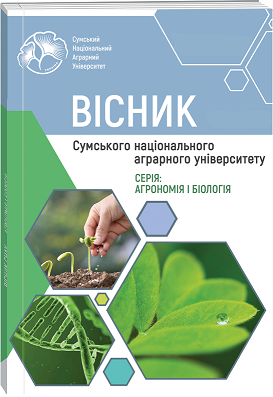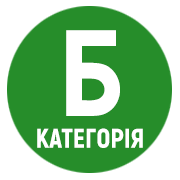PHYTOSANITARY RISK OF SPREAD AND REPRODUCTION OF QUARANTINE ORGANISMS, CONTROL OF THEIR NUMBER IN THE CONDITIONS OF THE SUMY REGION OF UKRAINE
Abstract
The littering of lands of different purposes of Sumy region of Ukraine, with quarantine weeds of ragweed and field cover was analyzed. The research was conducted in 2018‒2020 in the conditions of Sumy region, which is territorially part of the north-eastern part of the left-bank Forest-Steppe of Ukraine. Research methods are generally accepted. In the list of quarantine organisms of limited distribution in Ukraine (A-2), 5 species of insects, 5 diseases, 1 nematode and 6 species of weeds are widespread in our country. Hyphantria cunea, Globodera rostochiensis, Ambrósia artemisiifolia, Cuscuta cam-pestris Yuncker are widespread in the Sumy region. H. cunea is distributed in 6 districts of the region: Velykopysarivsky, Konotop, Okhtyrsky, Romensky, Trostyanetsky and Sumy on the area of 10.0; 40.0; 5.0; 167.0; 11.2; 5.6 hectares, respectively. The total af-fected area was 238.81 hectares. G. rostochiensis was found in 4 districts of the region: Okhtyrsky (17.19), Seredino-Budsky (140.43), Sumy (335.21), Yampilsky (77.12), on an area of 569.95 hectares. A. artemisiifolia was found in 18 districts of the region: (Bilopilsky, Burynsky, Velykopysarivsky, Glukhivsky, Konotop, Krasnopilsky, Krolevets, Lebedynsky, Lipovodolinsky, Nedrygailivsky, Okhtyrsky, Putivlsky, Romensky, Seredino-Budsky, Sumy, Trostyanetsky, Shostkynsky, Yampilsky) settlements, on the area of 1834.3 hectares. The largest area of infection is observed in Buryn, Velykopysarivsky, Konotop, Krasnopil districts, Sumy: respectively 200.7; 188.9; 237.5; 371.7; 100.0 hectares. In most districts, non-agricultural lands are infected, with the exception of Buryn, Konotop and Krasnopil and Lipovodolinsky districts. Private homesteads of citizens were free of ragweed. C. campestris was found in Velykopysarivskyi district on the area of one hectares.
References
2. Ahrarnyi cektor Ukrainy. Buriany. Ambroziia polynolycta. [Weeds. Ambrosia artemisiifolia]. [Electronic resource]. Access mode: http://surl.li/mjrv (in Ukrainian).
3. Borzykh, O. I. (2012). Fitocanitarna bezpeka Ukrainy [Phytosanitary safety of Ukraine]. Zakhyct i karantyn roclyn, 58, 3‒8. (in Ukrainian).
4. Borzykh, O. I. (2014). Karantynni buriany v Ukraini [Quarantine weeds in Ukraine]. Karantyn i zakhyst roslyn, 8, 11‒14. (in Ukrainian).
5. Burdulaniuk, A. O., Rozhkova, T. O., & Tatarynova, V. I. (2018). Ocnovy karantynu roclyn [Basics of plant quarantine]. Navchalnyi posibnyk. SNAU, Sumy, 151 (in Ukrainian).
6. Den'. V OON nazvaly chyselnist naselennia Zemli [The OUN named the population of the Earth]. [Electronic resource]. Access mode: https://is.gd/khlEbq (in Ukrainian).
7. Derzhavna sluzhba Ukrainy z bezpechnocti kharchovykh produktiv ta zakhyctu spozhyvachiv [State Service of Ukraine for Food Safety and Consumer Protection]. [Electronic resource]. Access mode: http://www.consumer.gov.ua (in Ukrainian).
8. Derzhavna sluzhba Ukrainy z pytan bezpechnosti kharchovykh produktiv ta zakhystu spozhyvachiv. Derzhavna ustanova "Kirovohradska oblasna fitosanitarna laboratoriia" [State Service of Ukraine for Food Safety and Consumer Protection. Kirovohrad Regional Phytosanitary Laboratory State Institution]. [Electronic resource]. Access mode: http://fitolab.kr.ua/ (in Ukrainian).
9. Derzhavna sluzhba Ukrainy z pytan bezpechnosti kharchovykh produktiv ta zakhystu spozhyvachiv. Derzhavna ustanova "Ternopilska oblasna fitosanitarna laboratoriia". [State Service of Ukraine for Food Safety and Consumer Protection. Ternopil Regional Phytosanitary Laboratory State Institution Cuscuta campestris]. [Electronic resource]. Access mode: http:// http://surl.li/ttid (in Ukrain-ian).
10. Derzhavna ustanova «Sumcka oblasna fitosanitarna laboratoriia» [Sumy Regional Phytosanitary Laboratory]. [Electronic resource]. Access mode: http://surl.li/mjqy (in Ukrainian). 11. García, M. A., Costea, M., Kuzmina M. & Stefanovic, S. (2014). Phylogeny, character evolution, and biogeography of Cuscuta (dodders; Convolvulaceae) inferred from coding plastid and nuclear sequences. Am. J., 101, 670–690. doi: 10.3732/ajb.1300449. 12. Hibberd, J. M., Bungard, R. A., Press, M. C., Jeschke, W. D., Scholes, J. D., & Quick, W. P. (1998). Localization of photosynthetic metabolism in the parasitic angiosperm Cuscuta reflexa. Planta, 205, 506–513. doi: 10.1007/s004250050349.
13. Holovne upravlinnia Derzhprodspozhyvsluzhby v Sumskii oblasti. [The main department of the State Consumer Service in Sumy region]. Upravlinnia fitosanitarnoi bezpeky. [Electronic resource]. Access mode: http://surl.li/mjrh (in Ukrainian).
14. Horiacha L. M., & Zhuravel, I. O. (2014). Elementnyi sklad ambrozii polynolyctoi (Ambrosia artemisiifolia) [Elemental com-position. (Ambrosia artemisiifolia)]. Ukrainckyi medychnyi almanakh, 17(1), 145‒146 (in Ukrainian).
15. Hrynko A. V., & Taradyn S. A. (2018) Ekonomycheskaia otsenka prymenenyia pochvennykh herbytsydov na podsolnech-nyke [Economic evaluation of the use of soil herbicides on sunflower]. Ekonomyka y byznes: teoryia y praktyka, Nauchnyi zhurnal. [Electronic resource]. Access mode: http://surl.li/mmja (in Russian).
16. Infoindustriia. Vash putevodytel v myre ahroindustryy. Ambroziia polynolysta [Infoindustry. Your guide to the world of the agroindustry]. [Electronic resource]. Access mode: https://is.gd/D1SJhH (in Russian).
17. Kasmynyn, H. H. (2004). Effektivnost' osnovnoj obrabotki pochvy v upravlenii faktorami pochvennogo plodorodija pri vozde-lyvanii podsolnechnika na chernozeme vyshhelachennom Central'nogo Predkavkaz'ja [The effectiveness of the maine tillage in the management of soil fertility factors in the cultivation of sun flower on leached black soil of the Central Ciscaucasia]. [Electronic re-source]. Access mode: http://surl.li/mmfj (in Russian).
18. Kosolap, M. P. (2004). Herbolohiia [Herbology]. Navchalnyi posibnyk. Aristei, Kyiv, 367 (in Ukrainian).
19. List Vasc. Pl., Isles, Br. (2015). Biological Flora of the British Isles. Ambrosia artemisiifolia. Journal of Ecology, 103, 1069–1098,135, 74, 1 doi: 10.1111/1365-2745.12424
20. Neilyk, M. M. (2008). Herbolohichnyi monitorynh ahrotsenoziv ta osoblyvosti poshyrennia ambrozii polynolyctoi u Vinnytskii oblasti. Kormy i kormovyrobnytstvo [Herbological monitoring of agrocenoses and peculiarities of Ambrosia artemisiifolia L. distribution]. Mizhvidomchyi tematychnyi naukovyi zbirnyk, 60, 79‒82 (in Ukrainian). 21. Niculescu, M., Fagaras, M. M., Olaru, L. A., & Niculescu, L. (2016). The corology, egology and phytosociogy of the Ambro-sia artemisiifólia L., invasive alien plantin the southwestern part of Romania. International Multidisciplinary Scientific Geo Conference: Sofia: Surveying Geology & Mining Ecology Management (SGEM). Sofia, 3, 363‒370. doi: 10.5593/SGEM2016/HB63/S08.047. 22. Press, M. C., Scholes, J. D., & Watling, J. R. (1999). Parasitic plants: physiological and ecological interactions with their hosts. Physiological plant ecology. Blackwell Science, Oxford, UK, 175–197. doi: 10.1093/aob/mcn214.
23. Pro zatverdzhennia Instruktsii z vyiavlennia, lokalizatsii ta likvidatsii vohnyshch karantynnykh burianiv [About the statement of the instruction on detection, localization and liquidation of the centers of quarantine weeds]. [Electronic resource]. Access mode: http://surl.li/vsks
24. Pylypenko, L. A. (2016). Analiz fitocanitarnoho ryzyku rehulovanykh shkidlyvykh orhanizmiv, vidsutnikh v Ukraini [Analysis of phytosanitary risk of regulated pests absent in Ukraine], Koloobih, Kyiv, 56 (in Ukrainian).
25. Samotoivka. Wikipedia. [Electronic resource]. Access mode: https://is.gd/foAqmv 26. Saric-Krsmanovic, M., Bozic, D., Radivojevic, L., & Umiljendic, J. G. (2019). Vrbnicanin Response of alfalfa and sugar beet to field dodder (Cuscuta campestris Yunck.) parasitism: a physiological and anatomical approach. Canadian Journal of Plant Science, 99‒209. doi.org/10.1139/CJPS-2018-0050. 27. Saric-Krsmanovic, M. M., Bozic, D. M., Radivojevic, L. M., Gajic Umiljendic, J. S., & Vrbnicanin, S. P. (2017). Effect of Cuscuta campestris parasitism on the physiological and anatomical changes in untreated and herbicide-treated sugar beet. J. Environ. Sci. Health, Part B: Pestic., Food Contam., Agric. Wastes, 52, 812–816. doi: 10.1139/cjps-2018-0050. 28. Skálová, H. Guo WenYong, Wild, J. & Pyšek, P. (2017). Ambrosia artemisiifolia in the Czech Republic: history of invasion, current distribution and prediction of future spread, Preslia, 89(1), 1‒16. doi: 10.23855/preslia.2017.001
29. Stankevych, S. V. (2017). Metody ohliadu ta ekspertyzy pidkarantynnykh materialiv [Methods of inspection and examination of quarantine materials]. Navch. Posibnyk. FOP Brovin O.V., Kharkiv, 255 (in Ukrainian).
30. Uhoda pro asotsiatsiiu. Uriadovyi portal [Association Agreement. Government portal]. [Electronic resource]. Access mode: https://is.gd/rWwL9J (in Ukrainian).
31. Vasylieva, T. V., Kovalenko, S. H., & Nemertsalov, V. V. (2017). Floro-henetychnyi analiz fitobioty ostrova Zmiinyi (Chorne more, Ukraina) [Floro-genetic analysis of Snake Island (Black Sea, Ukraine)]. Naukovi zapysky Ternopilskoho natsionalnoho pedaho-hichnoho universytetu imeni Volodymyra Hnatiuka. Seriia: Biolohiia, 2, 16‒20 (in Ukrainian).
32. Yeshchenko, V. O., Kopytko, P. H., & Kostohryz, P. V. (2005). Osnovy naukovykh doslidzhen v ahronomii: pidruch [Fundamentals of scientific research in agronomy]. Diia, Kyiv, 186 (in Ukrainian).

 ISSN
ISSN  ISSN
ISSN 


